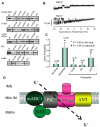Mitochondrial K(ATP) channels in cell survival and death
- PMID: 15978901
- PMCID: PMC2692534
- DOI: 10.1016/j.yjmcc.2004.12.003
Mitochondrial K(ATP) channels in cell survival and death
Abstract
Since the discovery of the mitochondrial ATP-sensitive potassium channel (mitoK(ATP)) more than 13 years ago, it has been implicated in the processes of ischemic preconditioning (IPC), apoptosis and mitochondrial matrix swelling. Different approaches have been employed to characterize the pharmacological profile of the channel, and these studies strongly suggest that cellular protection well correlates with the opening of mitoK(ATP). However, there are many questions regarding mitoK(ATP) that remain to be answered. These include the very existence of mitoK(ATP) itself, its degree of importance in the process of IPC, its response to different pharmacological agents, and how its activation leads to the process of IPC and protection against cell death. Recent findings suggest that mitoK(ATP) may be a complex of multiple mitochondrial proteins, including some which have been suggested to be components of the mitochondrial permeability transition pore. However, the identity of the pore-forming unit of the channel and the details of the interactions between these proteins remain unclear. In this review, we attempt to highlight the recent advances in the physiological role of mitoK(ATP) and discuss the controversies and unanswered questions.
Figures

References
-
- Kloner RA, Bolli R, Marban E, Reinlib L, Braunwald E. Medical and cellular implications of stunning, hibernation, and preconditioning: an NHLBI workshop. Circulation. 1998;97:1848–67. - PubMed
-
- Murry CE, Jennings RB, Reimer KA. Preconditioning with ischemia: a delay of lethal cell injury in ischemic myocardium. Circulation. 1986;74:1124–36. - PubMed
-
- Cohen MV, Baines CP, Downey JM. Ischemic preconditioning: from adenosine receptor of KATP channel. Annu Rev Physiol. 2000;62:79–109. In Process Citation. - PubMed
-
- Zhang DX, Chen YF, Campbell WB, Zou AP, Gross GJ, Li PL. Characteristics and superoxide-induced activation of reconstituted myocardial mitochondrial ATP-sensitive potassium channels. Circ Res. 2001;89:1177–83. - PubMed
-
- Sato T, O'Rourke B, Marban E. Modulation of mitochondrial ATP-dependent K+ channels by protein kinase C. Circ Res. 1998;83:110–4. - PubMed
Publication types
MeSH terms
Substances
Grants and funding
LinkOut - more resources
Full Text Sources

